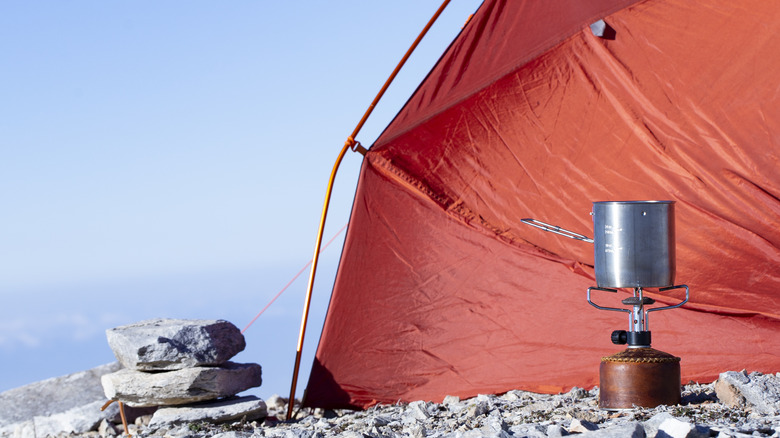The Simple Trick For Purifying Water When You're In The Wild
There's nothing quite like the peace and adventure of being in nature. But that thrill can vanish quickly without clean drinking water. While there are methods to identify potentially safe streams (flowing water is a good sign), and some even argue against water as the ultimate hydration source, sometimes you find yourself caught off guard. In those moments of uncertainty, it's important to know which water sources are best to drink. But it's also vital to understand how to purify that water. Thankfully, there's a simple trick you can use for peace of mind: boiling.
While it might seem basic, boiling is one of the most effective ways to eliminate harmful bacteria, viruses, and parasites from water. It's important to remember, however, that while boiling is a champion against biological threats, if you're concerned about chemical contaminants or heavy metals, it might be worth exploring other options. But let's first explore why boiling works and how to implement this simple technique.
Why boiling water works
Microscopic organisms like bacteria and viruses thrive in water. They can cause a variety of unpleasant and potentially dangerous illnesses, like diarrhea, vomiting, and even more serious conditions. Boiling disrupts the cell structure of these organisms, rendering them inactive and safe to ingest.
This method is reliable and effective at most elevations, but remember that boiling time changes with altitude. At lower levels (below 6,500 feet), a vigorous boil for just one minute is enough. However, as you climb higher, the air thins, and water boils at a lower temperature. To compensate for this, the Centre for Disease Control and Prevention recommends extending the boiling time to 3 minutes.
While boiling tackles biological threats, chemical contaminants and heavy metals require a different approach. This is where seeking insights from park rangers or experienced hikers familiar with the local water sources becomes crucial. Their knowledge can be invaluable in determining if additional purification is necessary. Based on their advice, you might choose to supplement boiling with water treatment tablets, a portable filter, or even a purifier for the ultimate protection, ensuring your wilderness experience remains worry-free.
Other options for purifying water
Chemical treatment tablets are convenient and lightweight, making them a popular choice for backpackers. However, proper dosing is crucial to avoid ingesting harmful amounts of chlorine or iodine. Some tablets offer better protection against giardia, a common parasite, but they won't eliminate cryptosporidium, another nasty parasite.
Filters, on the other hand, are like tiny sieves, physically trapping microorganisms in their pores. For protection against giardia and cryptosporidium, opt for a filter with a pore size of 1 micron or less. Remember, filters don't kill the trapped organisms, so regular cleaning (usually by backwashing with clean water) or filter cartridge replacement is essential to maintain effectiveness. There are two main types of filters: pump filters, which require manual effort to push water through, and gravity filters, which use gravity to do the work for you. Gravity filters are slower but ideal for larger groups.
Purifiers are the ultimate water treatment tools, offering the most comprehensive protection. They often combine microfiltration with additional methods like ultraviolet (UV) light or specialized chemicals to not only eliminate bacteria and parasites but also inactivate viruses. This advanced purification is ideal for regions with high viral risks or for travelers with compromised immune systems. However, purifiers tend to be heavier and more expensive than other options, and UV purifiers may require multiple treatments for cloudy water.


